一、OGNL表达式
1.简介
OGNL:对象视图导航语言. ${user.addr.name} 这种写法就叫对象视图导航。
OGNL不仅仅可以视图导航.支持比EL表达式更加丰富的功能。
2.使用OGNL准备工作
2.1导包
struts2 的包中已经包含了.所以不需要导入额外的jar包
2.2代码准备
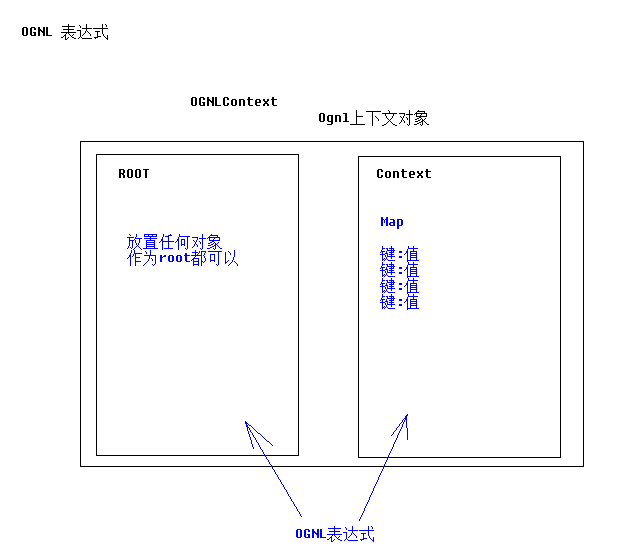

@Test //准备工作 public void fun1() throws Exception{ //准备OGNLContext //准备Root User rootUser = new User("tom",18); //准备Context Map<String,User> context = new HashMap<String,User>(); context.put("user1", new User("jack",18)); context.put("user2", new User("rose",22)); OgnlContext oc = new OgnlContext(); //将rootUser作为root部分 oc.setRoot(rootUser); //将context这个Map作为Context部分 oc.setValues(context); //书写OGNL Ognl.getValue("", oc, oc.getRoot()); }
3.基本语法演示

//取出root中user对象的name属性 String name = (String) Ognl.getValue("name", oc, oc.getRoot()); Integer age = (Integer) Ognl.getValue("age", oc, oc.getRoot()); System.out.println(name); System.out.println(age);

//取出context中键为user1对象的name属性 String name = (String) Ognl.getValue("#user1.name", oc, oc.getRoot()); String name2 = (String) Ognl.getValue("#user2.name", oc, oc.getRoot()); Integer age = (Integer) Ognl.getValue("#user2.age", oc, oc.getRoot()); System.out.println(name); System.out.println(name2); System.out.println(age);

//将root中的user对象的name属性赋值 Ognl.getValue("name='jerry'", oc, oc.getRoot()); String name = (String) Ognl.getValue("name", oc, oc.getRoot()); String name2 = (String) Ognl.getValue("#user1.name='郝强勇',#user1.name", oc, oc.getRoot()); System.out.println(name); System.out.println(name2);

//调用root中user对象的setName方法 Ognl.getValue("setName('lilei')", oc, oc.getRoot()); String name = (String) Ognl.getValue("getName()", oc, oc.getRoot()); String name2 = (String) Ognl.getValue("#user1.setName('lucy'),#user1.getName()", oc, oc.getRoot()); System.out.println(name); System.out.println(name2);

String name = (String) Ognl.getValue("@cn.itheima.a_ognl.HahaUtils@echo('hello 强勇!')", oc, oc.getRoot());
//Double pi = (Double) Ognl.getValue("@java.lang.Math@PI", oc, oc.getRoot());
Double pi = (Double) Ognl.getValue("@@PI", oc, oc.getRoot());
System.out.println(name);
System.out.println(pi);

//创建list对象 Integer size = (Integer) Ognl.getValue("{'tom','jerry','jack','rose'}.size()", oc, oc.getRoot()); String name = (String) Ognl.getValue("{'tom','jerry','jack','rose'}[0]", oc, oc.getRoot()); String name2 = (String) Ognl.getValue("{'tom','jerry','jack','rose'}.get(1)", oc, oc.getRoot()); /*System.out.println(size); System.out.println(name); System.out.println(name2);*/ //创建Map对象 Integer size2 = (Integer) Ognl.getValue("#{'name':'tom','age':18}.size()", oc, oc.getRoot()); String name3 = (String) Ognl.getValue("#{'name':'tom','age':18}['name']", oc, oc.getRoot()); Integer age = (Integer) Ognl.getValue("#{'name':'tom','age':18}.get('age')", oc, oc.getRoot()); System.out.println(size2); System.out.println(name3); System.out.println(age);
二、OGNL与Struts2的结合
1.结合原理

ValueStack中的两部分

2.栈原理

栈是由ArrayList模拟的

栈中的两个方法的实现
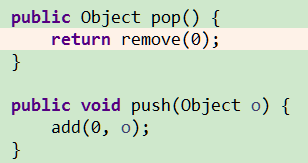
访问栈中属性的特点.由上到下

3.查看值栈中两部分内容(使用DEBUG标签)
3.1Root
默认情况下,栈中放置当前访问的Action对象
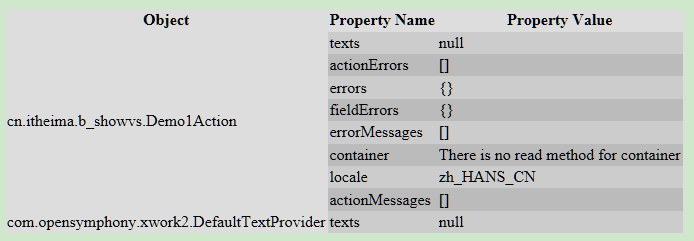
3.2Context
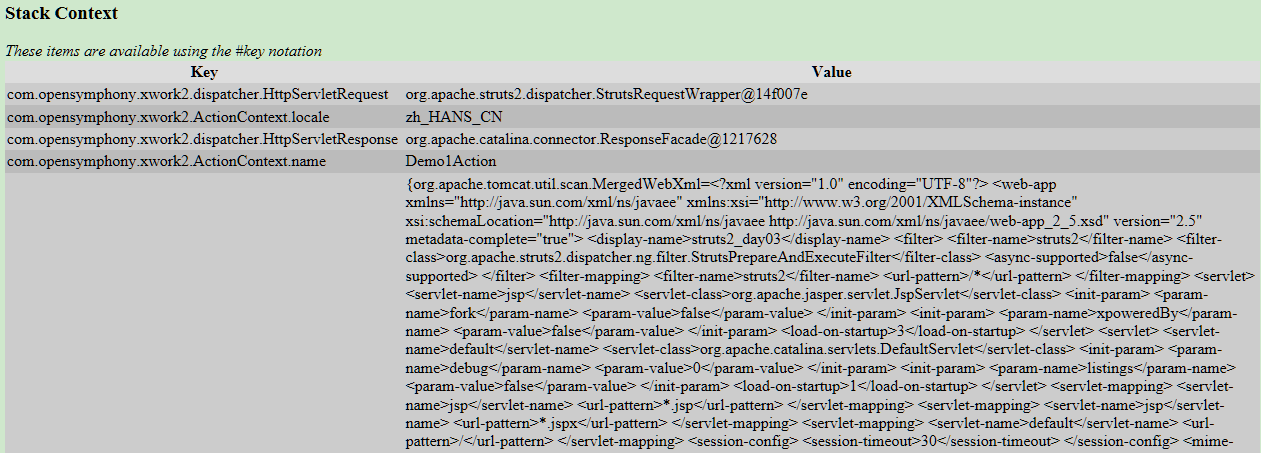

Context部分就是ActionContext数据中心
4.struts2与ognl结合体现
4.1参数接收

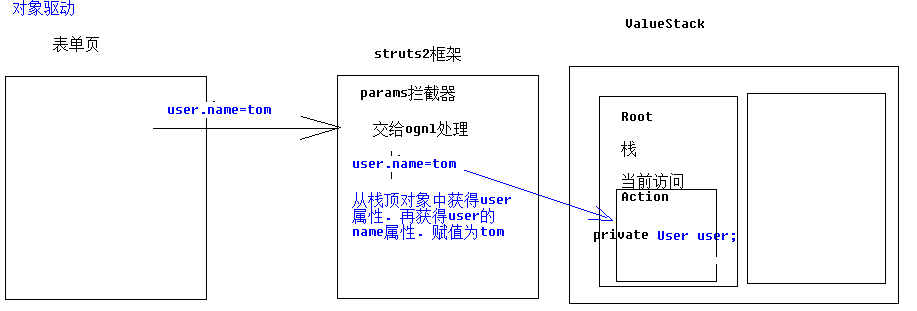

如何获得值栈对象,值栈对象与ActionContext对象是互相引用的
//压入栈顶 //1获得值栈 ValueStack vs = ActionContext.getContext().getValueStack(); //2将u压入栈顶 vs.push(u);
4.2配置文件中

<action name="Demo3Action" class="cn.itheima.d_config.Demo3Action" method="execute" > <result name="success" type="redirectAction" > <param name="actionName">Demo1Action</param> <param name="namespace">/</param> <!-- 如果添加的参数struts"看不懂".就会作为参数附加重定向的路径之后. 如果参数是动态的.可以使用${}包裹ognl表达式.动态取值 --> <param name="name">${name}</param> </result> </action>
5.扩展:request对象的getAttribute方法
查找顺序:

三、练习:客户列表

public String list() throws Exception { //1 接受参数 String cust_name = ServletActionContext.getRequest().getParameter("cust_name"); //2 创建离线查询对象 DetachedCriteria dc =DetachedCriteria.forClass(Customer.class); //3 判断参数拼装条件 if(StringUtils.isNotBlank(cust_name)){ dc.add(Restrictions.like("cust_name", "%"+cust_name+"%")); } //4 调用Service将离线对象传递 List<Customer> list = cs.getAll(dc); //5 将返回的list放入request域.转发到list.jsp显示 //ServletActionContext.getRequest().setAttribute("list", list); // 放到ActionContext ActionContext.getContext().put("list", list); return "list"; }

<s:iterator value="#list" var="cust" > <TR style="FONT-WEIGHT: normal; FONT-STYLE: normal; BACKGROUND-COLOR: white; TEXT-DECORATION: none"> <TD> <s:property value="#cust.cust_name" /> </TD> <TD> <s:property value="#cust.cust_level" /> </TD> <TD> <s:property value="#cust.cust_source" /> </TD> <TD> <s:property value="#cust.cust_linkman" /> </TD> <TD> <s:property value="#cust.cust_phone" /> </TD> <TD> <s:property value="#cust.cust_mobile" /> </TD> <TD> <a href="${pageContext.request.contextPath }/customerServlet?method=edit&custId=${customer.cust_id}">修改</a> <a href="${pageContext.request.contextPath }/customerServlet?method=delete&custId=${customer.cust_id}">删除</a> </TD> </TR> </s:iterator> <%-- <s:iterator value="#list" > <TR style="FONT-WEIGHT: normal; FONT-STYLE: normal; BACKGROUND-COLOR: white; TEXT-DECORATION: none"> <TD> <s:property value="cust_name" /> </TD> <TD> <s:property value="cust_level" /> </TD> <TD> <s:property value="cust_source" /> </TD> <TD> <s:property value="cust_linkman" /> </TD> <TD> <s:property value="cust_phone" /> </TD> <TD> <s:property value="cust_mobile" /> </TD> <TD> <a href="${pageContext.request.contextPath }/customerServlet?method=edit&custId=${customer.cust_id}">修改</a> <a href="${pageContext.request.contextPath }/customerServlet?method=delete&custId=${customer.cust_id}">删除</a> </TD> </TR> </s:iterator> --%>
注意:<s:iterator value="#list" var="cust" > 每次都会把cust存在ActionContext中
